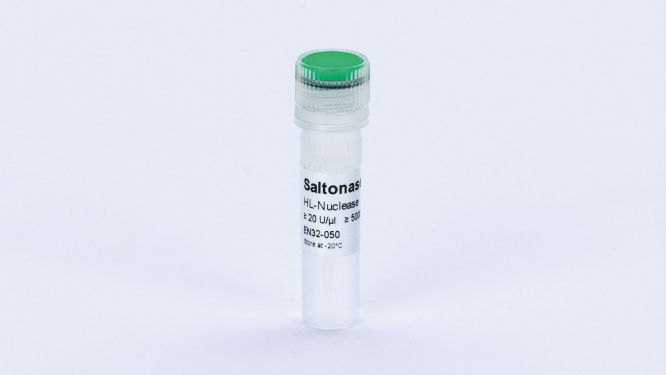Cat. No. / ID: EN32-050
Features
- Highly active in a broad range of temperatures (>20% at 15–55°C)
- Maximum nucleolytic activity at high salt concentrations (optimal concentration for NaCl or KCl is 450-600 mM) and other buffer additives
- Highly active in the typical buffers and grow media
- Requires ≥ 1 mM Mg2+ to activate and shows a broad spectrum of pH activity (optimum at pH 8.5, working pH range >20% 6.8–9.3)
Product Details
Saltonase is a high salt- and broad pH-active recombinant endonuclease produced in E.coli. Saltonase originates from psychrophilic bacteria and effectively digests all types of DNA and RNA substrates in different buffer conditions and a broad range of temperatures. It is very active in demanding conditions, including broad-ranging temperatures and an environment with high salt content. These features make Saltonase extremely useful for removing undesired nucleic acid contamination during the purification of proteins in laboratory and manufacturing workflows.
It is supplied with 20 mM Tris-HCl pH 7.1; 620 mM NaCl; 26 mM MgCl2; 50% (v/v) glycerol.
One unit is defined as the amount of enzyme that causes an increase in absorbance at 260 nm of 1.0 in 30 minutes at 37°C in 50 mM Tris-HCl buffer, pH 8.5 (25°C) supplemented with 500 mM NaCl, 5mM MgCl2, 0.1 mg/mL BSA and 0.5 mg/mL herring sperm DNA as a substrate.
Performance
| Assay | Specification |
| Purity | >95% |
| Protease activity | None detected |
Principle
Saltonase cleaves nucleic acids (NA) including ds and ss DNA and RNA. It remains active at temperatures ranging between 15 and 55 °C and in a high salt-content environment. It is particularly applicable for removing contaminating nucleic acids during the purification of different proteins in laboratory and manufacturing workflows.
Procedure
Quality Control
Protein purity is determined using assay by SDS-PAGE electrophoresis resulting in >95% purity.
Usage
- The optimal, final concentration of Saltonase in a reaction depends on several factors (level of nucleic acids contamination, incubation temperature and time, salt concentration and other compounds present in the reaction mixture). Much more Saltonase is needed for total nucleic acid removal than viscosity reduction. The amount of Saltonase and incubation conditions have to be determined experimentally (we recommend using 5–100 U of Saltonase per 1 mL of the reaction mixture or lysate at 20–37°C for 30–60 minutes).
- For optimal Saltonase activity, Mg2+ ions are required.
Applications
This is used for applications such as:
- Purification of biologics from residual nucleic acids in biopharma manufacturing
- Purification of recombinant proteins and enzymes for research and diagnostic use
- Removal of undesired nucleic acids contamination in molecular biology reagents in demanding systems
- Reduction of viscosity in biological samples during production and automation

